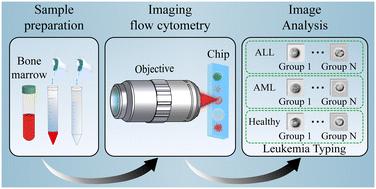Our official English website, www.x-mol.net, welcomes your
feedback! (Note: you will need to create a separate account there.)
Typing of acute leukemia by intelligent optical time-stretch imaging flow cytometry on a chip
Lab on a Chip ( IF 6.1 ) Pub Date : 2023-02-09 , DOI: 10.1039/d2lc01048h Yueyun Weng 1, 2 , Hui Shen 3 , Liye Mei 1 , Li Liu 3 , Yifan Yao 1 , Rubing Li 1 , Shubin Wei 1 , Ruopeng Yan 1 , Xiaolan Ruan 4 , Du Wang 1 , Yongchang Wei 5 , Yunjie Deng 6 , Yuqi Zhou 6 , Tinghui Xiao 6 , Keisuke Goda 1, 6, 7 , Sheng Liu 1, 2 , Fuling Zhou 3 , Cheng Lei 1, 6
Lab on a Chip ( IF 6.1 ) Pub Date : 2023-02-09 , DOI: 10.1039/d2lc01048h Yueyun Weng 1, 2 , Hui Shen 3 , Liye Mei 1 , Li Liu 3 , Yifan Yao 1 , Rubing Li 1 , Shubin Wei 1 , Ruopeng Yan 1 , Xiaolan Ruan 4 , Du Wang 1 , Yongchang Wei 5 , Yunjie Deng 6 , Yuqi Zhou 6 , Tinghui Xiao 6 , Keisuke Goda 1, 6, 7 , Sheng Liu 1, 2 , Fuling Zhou 3 , Cheng Lei 1, 6
Affiliation

|
Acute leukemia (AL) is one of the top life-threatening diseases. Accurate typing of AL can significantly improve its prognosis. However, conventional methods for AL typing often require cell staining, which is time-consuming and labor-intensive. Furthermore, their performance is highly limited by the specificity and availability of fluorescent labels, which can hardly meet the requirements of AL typing in clinical settings. Here, we demonstrate AL typing by intelligent optical time-stretch (OTS) imaging flow cytometry on a microfluidic chip. Specifically, we employ OTS microscopy to capture the images of cells in clinical bone marrow samples with a spatial resolution of 780 nm at a high flowing speed of 1 m s−1 in a label-free manner. Then, to show the clinical utility of our method for which the features of clinical samples are diverse, we design and construct a deep convolutional neural network (CNN) to analyze the cellular images and determine the AL type of each sample. We measure 30 clinical samples composed of 7 acute lymphoblastic leukemia (ALL) samples, 17 acute myelogenous leukemia (AML) samples, and 6 samples from healthy donors, resulting in a total of 227 620 images acquired. Results show that our method can distinguish ALL and AML with an accuracy of 95.03%, which, to the best of our knowledge, is a record in label-free AL typing. In addition to AL typing, we believe that the high throughput, high accuracy, and label-free operation of our method make it a potential solution for cell analysis in scientific research and clinical settings.
中文翻译:

芯片上智能光学时间拉伸成像流式细胞术分型急性白血病
急性白血病(AL)是最危及生命的疾病之一。AL的准确分型可显着改善其预后。然而,传统的 AL 分型方法通常需要对细胞进行染色,费时费力。此外,它们的性能受到荧光标记的特异性和可用性的高度限制,很难满足临床环境中 AL 分型的要求。在这里,我们通过微流控芯片上的智能光学时间拉伸 (OTS) 成像流式细胞术演示 AL 打字。具体来说,我们使用 OTS 显微镜以 780 nm 的空间分辨率以 1 ms -1的高流速捕获临床骨髓样本中的细胞图像以无标签的方式。然后,为了展示我们的方法在临床样本特征多样的临床效用,我们设计并构建了一个深度卷积神经网络 (CNN) 来分析细胞图像并确定每个样本的 AL 类型。我们测量了 30 个临床样本,其中包括 7 个急性淋巴细胞白血病 (ALL) 样本、17 个急性髓性白血病 (AML) 样本和 6 个来自健康供体的样本,总共获得了 227 620 张图像。结果表明,我们的方法可以区分 ALL 和 AML,准确率为 95.03%,据我们所知,这是无标签 AL 分型的记录。除了 AL 分型外,我们相信我们方法的高通量、高精度和无标记操作使其成为科学研究和临床环境中细胞分析的潜在解决方案。
更新日期:2023-02-09
中文翻译:

芯片上智能光学时间拉伸成像流式细胞术分型急性白血病
急性白血病(AL)是最危及生命的疾病之一。AL的准确分型可显着改善其预后。然而,传统的 AL 分型方法通常需要对细胞进行染色,费时费力。此外,它们的性能受到荧光标记的特异性和可用性的高度限制,很难满足临床环境中 AL 分型的要求。在这里,我们通过微流控芯片上的智能光学时间拉伸 (OTS) 成像流式细胞术演示 AL 打字。具体来说,我们使用 OTS 显微镜以 780 nm 的空间分辨率以 1 ms -1的高流速捕获临床骨髓样本中的细胞图像以无标签的方式。然后,为了展示我们的方法在临床样本特征多样的临床效用,我们设计并构建了一个深度卷积神经网络 (CNN) 来分析细胞图像并确定每个样本的 AL 类型。我们测量了 30 个临床样本,其中包括 7 个急性淋巴细胞白血病 (ALL) 样本、17 个急性髓性白血病 (AML) 样本和 6 个来自健康供体的样本,总共获得了 227 620 张图像。结果表明,我们的方法可以区分 ALL 和 AML,准确率为 95.03%,据我们所知,这是无标签 AL 分型的记录。除了 AL 分型外,我们相信我们方法的高通量、高精度和无标记操作使其成为科学研究和临床环境中细胞分析的潜在解决方案。











































 京公网安备 11010802027423号
京公网安备 11010802027423号